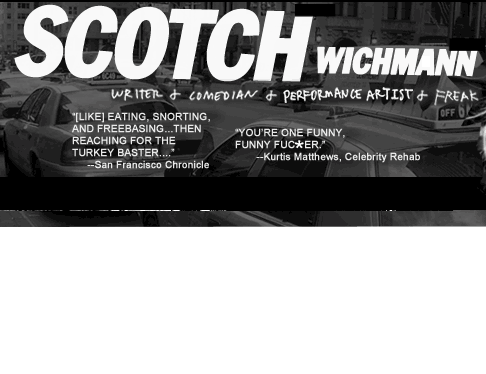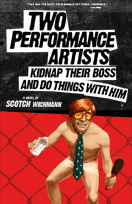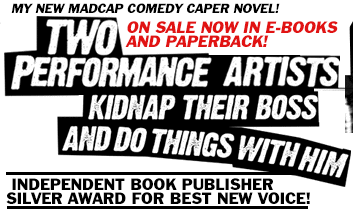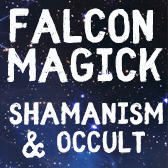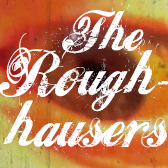Archive for the ‘Weird’ Category
Sunday, March 6th, 2016

Thank you everyone who came out last night to the monthly insanity at Ventura’s 5x5x5 Show! Such a wild night! The crowd was on fire, the performer lineup was inspiring (looking at you, Pete Ippel), and I had the chance to unveil You’re So Nice, a new piece about the tendency to keep negativity bottled up. Nice was originally slated to be part of a one-man show I had hoped to have finished by now, but my grad school workload has been heavier than I’d hoped, which is also why these blog posts have been far and few between.
This is the first time I’ve mentioned school here, in part because my impending degree has little to do with aesthetics (at first glance, anyway), and I’ve wanted to reserve this space for more uber-right-brained activities. But it’s high-time I outed myself: my “day job” involves working in cybersecurity.
Security’s been a lifelong interest. Even as a kid, I always had my nose in books about spies, criminal capers, the FBI, lockpicking, etc. My technical background started in the mid-1980s when I taught myself programming and joined a hacker/phreaker gang as a young teen. After getting scared straight by my own FBI encounter, I began working above-board in the security field in the 1990s. Since then, I’ve worked as a consultant, security architect, and hacker for 4 Fortune 500 companies (and counting), with an average stay of 4.5 years at each.
It’s a challenging balance, pulling fish out of my performance-art-pants at night, then wearing a poker face at a job where I’m tasked with fending off thousands of online attack attempts per day from amateur and state-sponsored hackers alike. A few of my co-workers know of my double life, but like any good spook, I’ve tried to keep a low profile; patients might prefer not knowing that their doctor rolls around in broken glass on weekends.
My take, however, is that cracking systems can be a creative act — which you know if you read my novel — and so hackers/crackers are often a very creative bunch. The very term “hacker” denotes someone inventive, whether it be in computers, turning toasters into telephones, or some other wacky trade. It follows that in order to “deflect” these creative people from wreaking digital havoc, defenders must be creative themselves, and be capable of seeing what hasn’t been shown (or even imagined) yet. The best defenders are, in many ways, visionaries capable of “seeing” the road long before any dirt has been moved. This is why it pays to exercise the right-brain by embracing occasional insanity to foster new synaptic routes orthogonal to Security’s inbred patterns.
I’ll finish my Security M.S. degree this December, and I’m increasingly realizing ways I might “hack” the subject of cybersecurity itself, with lessons learned from performance art. Who says the two subjects can’t inform each other? Playable glitches have been intentionally introduced into video games as an art form, so why can’t performance art “infect” cybersecurity as a new approach, a new way of thinking? And the converse can also be true. Security is very much about detecting what is breached, hidden, or taken; why can’t these apply to the performer-audience relationship in some explicit ways as well—or even be the focus of a performance?
Frankly—and I’m wagering every artist/performer who works a corporate day job can sympathize—I’ve been nervous for years that potential employers might discover my other work, and shy away from hiring me—but no more. How can I publicly pursue the intersection of art and security if I hide the fact that they already intersect for me intuitively? And really, why shouldn’t art and technology trade inspiration? They both come from the same brain, after all, in my case.
So, dear potential employers, please hire me for my cybersecurity skillz…and consider the fish in my pants a bonus.
Posted in Confessions, Cybersecurity, Performance art, Weird | 4 Comments »
Monday, November 2nd, 2015
I’ll be performing some serious weirdness at this Friday’s Andy Kaufman-inspired Kauf-Drops Show at the UCB Theatre in Hollywood. Come for some post-Halloween insanity! UCB Theatre, Friday, November 6, 2015, 8PM. 5419 W Sunset Blvd. FREE! See you there!
Posted in Comedy, Los Angeles, Performance art, Psycho, Weird | 2 Comments »
Thursday, July 30th, 2015

I was 16 when I discovered performance artist (or really, über artist) Chris Burden. I’d opened a library book to a black-and-white photo of a young, shirtless man crawling across a nighttime parking lot that was covered in glittering, broken glass. Arms behind his back. Rolling side to side. Getting cut up. My god, I thought.
I turned the page. Another photo: the same man nailed to the back of a Volkswagen. Then another: the man in an art gallery after being shot in the arm by a .22 caliber rifle. Artist Chris Burden, the book said. Something clicked in my brain; at that moment, my idea of what art was—what it could be—was never the same.
I had read some of Conceptual Art’s history, but obviously not much about Performance Art, so the discovery of Chris Burden was a revelation. His work was the first time I’d encountered the idea of a body doing something uncodified—that is, not Dance, Drama, Oratory, Circus, but Other—as art. Chris Burden had, I realized, made up his own art form, and not just once, but over and over again. There was no precedent for his pieces; they’d fallen from the sky, alien, unpredictable, dangerous, primal, silent.
For me, his performances were about suffering. In every photo, Burden was alone, without an audience, and his face was neutral. Nothing forced. No emotional mask. Placid. An Everyman, with whatever pain or discomfort he was feeling suppressed, held captive. This resonated with me, with my own childhood cycles of pain—separation, dispair, guilt, pennance. Burden had been called a Body Artist, but in truth he was a Pain Artist: his suffering encouraged the projection of our pain, our sympathy, even our empathy, onto his waiting countenance.
Burden’s death on May 10, 2015 was a terrible blow, the loss of a hero. I never wanted to emulate him—his work was too perfect and unthinkably painful to emulate—but I chose the same alma mater as his, in part to be “near” him and his history—to perform in the same school art galleries where he had quietly bled, suffocated, cried, and discovered, alone.
When the John White Gallery invited me to perform at Ventura Art Walk in July, 2015, I decided to crawl shirtless across broken windshield glass, just as Burden had in his 1973 piece, Through The Night Softly. Despite my love of his work, I had never done a piece that would be intentionally damaging to me physically—but I needed to know firsthand something of what he had felt, of what he had experienced in his pain.
My wife KayDee and I drove to Ventura, laid out a 12-foot-long swath of broken glass in the gallery’s parking lot, and then lined it on both sides with Matchbox cars—an homage to Burden’s many car-related performances and sculptures.
It was a hot day—about 91 degrees. Sun was blazing.
The piece began. I came running out from behind the gallery and sprinted across the parking lot with a 100-pound steel car door over my head. I used the door as an umbrella, then a racetrack, a seesaw, a drum, and then a stage. I climbed onto it wearing three white tanktops, which I pulled off one by one and threw into the sky like birds, chanting “BURD, BURD, BURD.”
As I chanted “BURD” and pulled off the last shirt, a white seagull landed behind me on the asphalt. The audience and I were stunned. Time slowed. It was Burden, I know it was, in feathered psychopomp regalia.
I walked to the start of the glass farthest from the audience, lay down, and begin to crawl. The asphalt was searing—I later learned it had been between 130 and 140 degrees Fahrenheit—and the grinding of the glass shards was unbearable. I have multiple tattoos, so I know something about persisting through enduring pain, but this was like nothing I had experienced. My chest was being grinded, stabbed, burned—I was on fire with tunnel vision. I had wanted to keep a placid Burden face, but it was impossible, so I submitted to animal cries as I pushed forward, crawling but unable to use my hands on the melting asphalt, the glass cutting my chest like ribbons, brain screaming for me to stop. The white seagull watched me silently from the gallery roof—it was my confessional and our communion. Sweat ran into my eyes and my hands were shaking like crazy. More animal cries escaped—they were uncontrollable, cries for Burden, the cries he had refused to let out back in 1973.
When I reached the last of the glass, I crawled across asphalt, through the car door’s empty window, and emerged out the other side. I stood up, dizzy and weak and shaking from adrenaline. My chest was bright red, mottled, and cut from the asphalt and glass. I looked down and saw glittering shards sticking out of ribs and a line of blood streaming from my elbow.
I picked up a goodbye Matchbox car, kissed it, and chucked it onto the gallery’s roof—but I was too spent. The throw was short—the car rained down from the roof and landed back on the asphalt. I walked to it, kissed it, and threw it again. Again, too short. My arms and legs were rubber. I picked it up once more. Kissed it. Threw it. It flew up and over the roof’s peripet—then nothing. Silence. None of us heard the car land. It never came down—flown into the heavens.
Thank you, Chris Burden. April 11, 1946—May 10, 2015.
Photos of the glass crawl here.
And see a great recap of the piece on The Polina Hryn Show here.
Tags: chris burden, crawl, glass
Posted in Los Angeles, Performance art, Violence, Weird | 6 Comments »
Sunday, May 10th, 2015
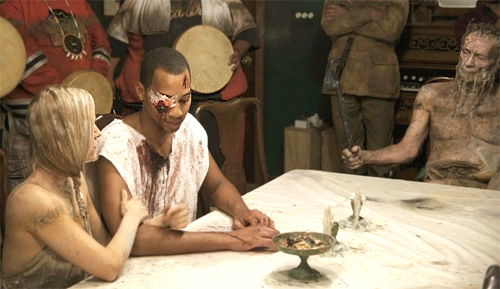
Last Saturday I attended UCLA’s West Coast unveiling of Matthew Barney‘s River of Fundament, a 6-hour death-and-reincarnation tale of a writer caught up with Egyptian gods that was inspired by Norman Mailer’s 1983 novel, Ancient Evenings.
Fundament is is an orgiastic adventure in every sense of the term. Egyptian shades of Kenneth Anger, David Lynch, David Cronenberg, Luis Buñuel, Joseph Beuys, Rudolf Schwarzkogler, Carolee Schneeman, The Kipper Kids, and The X-Files are smelted down into molten imagination that comes running out of every human orifice to drench viewers in color, carcass, and fuckable cars before a noxious, farting pantheon of dug-up-and-still-decaying Egyptian-god-cadavers eagerly lapping up the leftovers.
The story—whose summary could easily expand to fill a novel all its own—sets a dead Mailer to reincarnate himself three times into different human bodies through the womb of his wife, possibly in a veiled examination of his own success and failings as a writer. Each reincarnation starts with Norman surfacing in an underground sewage river of “fundament.” Soaked in feces, he emerges to slosh up a staircase to his Brooklyn apartment above, where his own funeral wake is in full swing with New York literary types, improvising musicians, and caterers.
Each ascent of the staircase finds the wake winding down further, if not decaying; the party’s culinary centerpiece—a roast pig on a spit, whose tongue is devoured by a sickly-pale Paul Giamatti—is polished off by maggots at the end, while remaining guests fall under hypnagogic spells that have them moaning and chanting, perhaps as a byproduct of the Egyptian magic all around. Meanwhile, the river-and-apartment storyline is paralleled by a second tale, in which Norman is imagined as three automobiles, each of which undergoes its own magnificent transfiguration about town.
Both narratives are interwoven with Egyptian lore, with Norman’s cohorts mapping to Isis, Osiris, Horus, and other gods, and symbolism that is layered impossibly deep: ibises, serpents, vultures, beetles, was scepters, hieroglyphs and cartouches, belled pectorals, daggers, Hathorian cattle and horns, hidden passages both vaginal and excretory, stairwells joining heaven to a shitty hell, and of course, phalli in every shape appear against walls of gold, avalanches of fire, and heads of lettuce.
Mobs of Ph.D. candidates have no doubt already trashed all previous dissertation ideas in favor being the first to publish on Fundament, even though, sadly, not enough has been written about Barney’s latest opus in the press.
Nearly all critics agree that the work is epic in scope, with moments of beauty that match or rival—even if only fleetingly—the most gorgeous and unique imagery ever set to avant-garde celluloid. In the same breath, many also dismiss the film as simply too long, or too inaccessible—even more so, some say, than Barney’s earlier Cremaster Cycle—or that the brown rivers of offal, shit-encrusted gods, and fetid sex with puckering anuses pressed against the lens are too unappetizing to digest.
I haven’t read Mailer’s Ancient Evenings yet, so I can’t attest to Fundament‘s fidelity there, but I can say that critics who evaluate Barney’s new effort only against rubrics that dictate films must be linear, or only make literal sense, or feature less noxious scenes, or tie up endings with tidy totalizing ribbons, have embarked on the journey with a fatal first misstep that nearly guarantees they’ll miss the film’s performative and pedagogic qualities.
(These same critics would probably render similar judgments against Un Chien Andalou—even though Buñuel’s masterpiece admittedly soothes by being five and a half hours shorter in length—and should therefore save their ink when it comes to surrealist works they don’t seem to want to understand ab initio, since digging for structure, meaning, relevance, and art history context is strenuous).
But it doesn’t matter, because, really, how can anyone criticize what amounts to a dream?
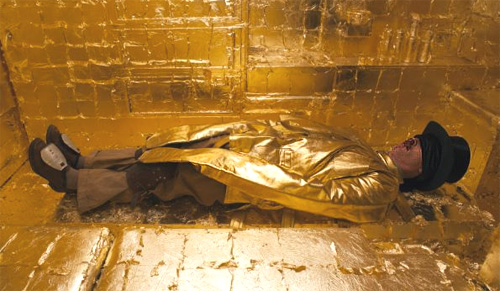
And a dream Fundament is—a performance art dream. Sure, it’s interspersed with some of narrative film’s familiar codes, but even those codes break down. The “narrative” of “normal” guests attending a wake collapses into chaotic scenes of their moaning, drooling, and being generally oblivious to the scatological Norman-narrative being draped across them, so even “normal” finds itself touched by Egyptian magic, which brings spontaneous opera, object-making, and occasionally violent delusions to anyone in its vicinity.
Freud marvels in his Der Dichter und Phantasiere at the writer’s magical ability to dissolve his/her identity into a work—to become all of the characters and the spaces in-between—and Barney manages this in spades, especially with regard to the in-between. Distinctions between performance art and film, object and subject, and the utilitarian and symbolic dissolve, just like the apartment walls in Fundament that double as membranes for gods to penetrate. In a page right out of a J.G. Ballard map, Barney pushes through into supposedly empty, useless areas—our primordial shit, our intellectual detritus, our industrial graveyards, our dead—using self-made vehicles that are in-between themselves, since that’s the kind of magic required to cross the river from the hell of rigid symbolism and (re)tired modes of thinking into imaginary places that are new.
Read around, and you may come to agree that many reviewers don’t know what to do with Fundament so far, even though the film provides the answer: namely, that critics need to create their own analytical and expressive vehicles appropriate to what they’re reviewing—especially when it’s experimental—rather than relying on punctilious categories of genre and medium that are easily off(al)ended. Perhaps we should hire performance artists for the job, since their art specializes in reconciling and synthesizing the surreal with the waking; ask one what we should do with Barney’s all-seeing anuses, foil-wrapped cocks, and cars leaking silvery sperm, and I bet answers won’t be long in coming.
Images © 2014 Matthew Barney. Text © 2015 Scotch Wichmann.
Tags: ancient evenings, film, fundament, matthew barney, norman mailer, review, river
Posted in Film/Video, Los Angeles, Weird, Writing | 1 Comment »
Saturday, November 1st, 2014
I’m crazy-excited to announce DICKTEMP, an art experiment to measure the temperature and humidity in my underwear 24/7 for the 30 days of November! Inspired by a dream I had about Matt Damon, check out DICKTEMP.COM for the current weather in my pants, or compare the daily graphs! And be sure to follow me on Twitter for the latest updates—it’s gonna be insane! #dicktemp


*** UPDATE: I just heard back from The Smithsonian—apparently the museum does not want to include my #dicktemp thermometer in its American Art collection. Maybe next time! ;)
*** UPDATE #2: Dicktemp is complete! What a crazy 30 days! Catch all the action in my #dicktemp video logs:
I might’ve gotten a little carried away on Day 20 with all of that amazing fannybag fashion…hahaha. Here’s the greenscreen supercut just for you!
Posted in Funny, Los Angeles, Performance art, Sex, Weird | 7 Comments »
Saturday, May 24th, 2014
The book tour has been racing ahead full steam, with exciting stops in LA, Fresno, San Francisco, Portland, Seattle, and this week, Washington D.C.
Though I’ve said it before, I’m still shocked at just how few indie bookstores remain compared to 10 or 20 years ago, with so many replaced by soulless stucco-and-glass monoliths. Thank the gods for indies—or better, go buy some books from them!
With so few non-chain bookstores remaining, and their calendars so packed with authors hungry for stage time, and their budgets continuing to thin (some have elminated book readings altogether because they can no longer afford event & marketing costs), traditional book tours are becoming a rarity. Even Barnes and Noble stores were an impassable challenge, which we tried to book in towns where there wasn’t a single indie bookstore left. Some B&Ns no longer hosted readings at all, it turned out, while the others were just too disorganized to recall a conversation from one phone call to the next, until time finally ran out.
But that doesn’t mean Book Tours are dead. Far from it. The thriving indie bookstores we booked were a dream. Skylight Books & Book Soup in LA—and my San Francisco favorite, Green Apple Books, with its old creaky floors & eclectic selection—pulled out all the stops, with mobs showing up crazy-excited for a performance art novel. (Full disclosure: though I’d like to think it was all due to my book’s appeal, part of the draw might’ve been rumors preceding me that I do wild things with a fish during my readings, but I’ll take crowds however I can get them!!!)
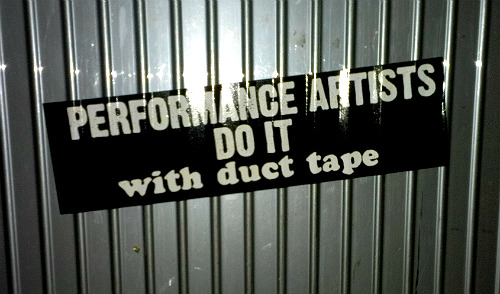
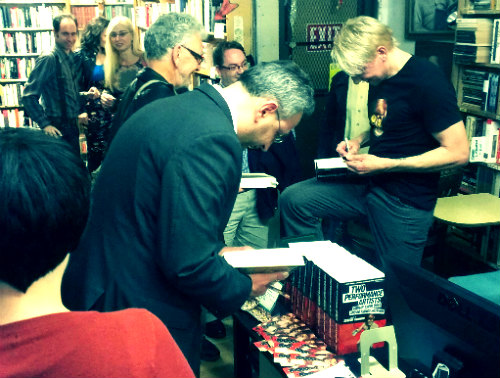
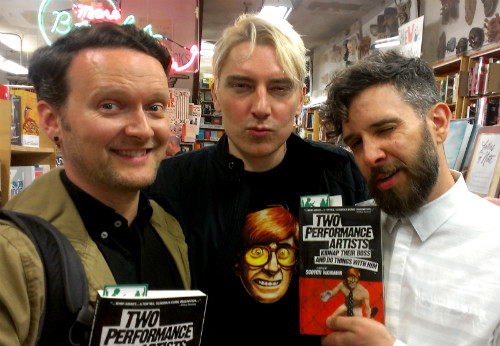
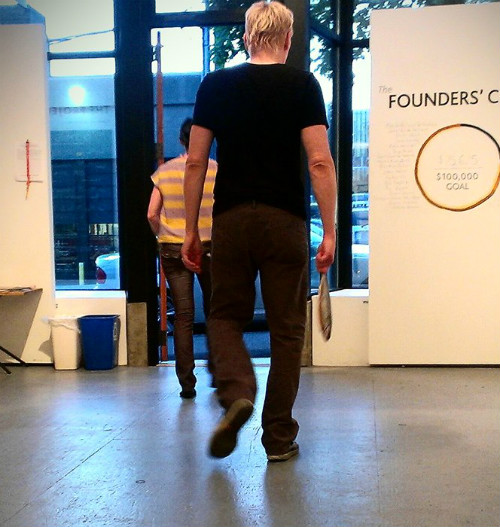
With the novel being about art & performance, we were also able to book some killer art, gallery, and alternative theater spaces, thanks to curators who were game. SoapCo. Gallery & Theater in Fresno’s Tower District, Mermaids Tattoo in SF, the Show & Tell Gallery in Portland, and Seattle’s The Project Room were not only white hot creative collaborators up for anything, but also fitting for a novel about two subversives who unleash peformances in sweaty underground galleries where art spectators go increasingly mad for performances that shred convention. Finding a way, hell or high water, to still get the book out felt like dancing amid the publishing industry’s ruins—and fucking punk rock performance art.
One of my favorite events was the tattoo happening at Mermaids Tattoo in SF. The evening began with a hilarious standup comedy set by SF favorite Loren Kraut, then a performance art piece by yours truly. Then came the finale: with the audience watching, Mermaids’ owner-and-tattoo-artist Anne Williams inked a tattoo that’s described in my novel onto my torso while my wife read the chapter aloud. It was surreal, grimacing under the buzzing needle while hearing my words echoed back to me. In the novel, protagonist Hank tries to tattoo himself while wearing a vest made of meat that’s being attacked by a massive dog; in the interests of public safety and my needle’s sterility, I forewent the meat and mutt.
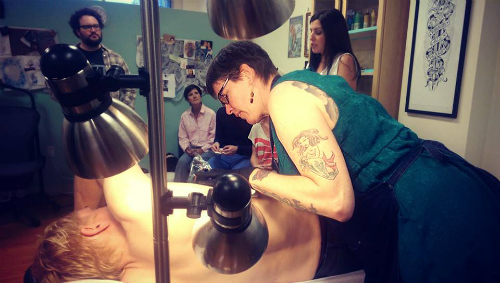
You can catch more photos on the book tour’s web page.
Posted in Book Tour, Los Angeles, Performance art, San Francisco, Weird, Writing | 1 Comment »
Monday, May 5th, 2014
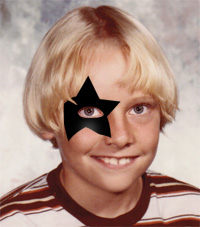 Off Paper, the literary journal for the cutting-edge Project Room gallery in Seattle, asked me to write about my very first hero. Picking a superhero seemed too easy, although I was willing to make an exception for Isis—it doesn’t get much cooler than a goddess who uses Egyptian magick to conjure a replacement dong out of gold for her drawn-and-quartered husband. A skill like that could come in handy. Off Paper, the literary journal for the cutting-edge Project Room gallery in Seattle, asked me to write about my very first hero. Picking a superhero seemed too easy, although I was willing to make an exception for Isis—it doesn’t get much cooler than a goddess who uses Egyptian magick to conjure a replacement dong out of gold for her drawn-and-quartered husband. A skill like that could come in handy.
In the end, the band KISS won out. A phallus made from Gene Simmons’ tongue was just too hard to beat.
Posted in Book Tour, Funny, Performance art, Weird, Writing | No Comments »
Wednesday, April 23rd, 2014
My best ideas come from the great outdoors. (And my worst).

Posted in Weird | 1 Comment »
Monday, January 27th, 2014
…So much, in fact, that he apparently lifted passages verbatim from my performance art manifesto for his recent “performance art plagiarism” on Twitter.
If this whole drama is news to you, it really started in late 2013 when the world learned LaBeouf had plagiarized word-for-word from Justin M. Damiano, a comic by Daniel Clowes, for LaBeouf’s short film Howard Cantour. Caught red-handed, but determined to laugh off his asininity, LaBeouf presented a mea culpa through plagiarized apologies on Twitter, then did a little skywriting, and then offered the excuse that this had all been “metamodernist performance art” — that, oh you know, his charmed life is really just a performance art piece — all of which climaxed with a final twittering of performance art aphorisms that read almost like a performance art manifesto. An astute tipster googled some of LaBeouf’s tweets, and lo, discovered they’d been lifted straight from the performance art manifesto on my web site, as well as from writings of performance artist Marina Abramovic and others.
You can check out his (un)original tweets, my manifesto (originally published in 2009 as evidenced by Archive.org), or compare them side-by-side. As payment for my writerly services, I won’t object if Shia wants to buy a few thousand copies of my novel when it comes out April 10th. I’ll even sign each one (unless, of course, he’d prefer to sign my signature himself? Ha).
I’ve received buckets of sympathy from supporters & cohorts, which I truly appreciate. Sincerely: thank you for having my back.
But I need to say for myself: I’m not without a sense of humor, nor do I lack appreciation for pastiche, sampling, intertextual play, remaking, invoking past influences, and the like; these are how humans push ideas forward.
I was reminded today (thanks, Mark Axelrod) that French-American writer Raymond Federman termed this kind of textual borrowing “playgiarism” to distinguish it from less artful, more insidious brands of thievery:
“To answer the question once and for all. I cannot explain how Playgiarism works. You do it or you don’t. You’re born a Playgiarizer or you’re not. It’s as simple as that. The laws of Playgiarism are unwritten. Like incest, it’s a taboo. It cannot be authenticated. The great Playgiarizers of all time — Homer, Shakespeare, Rabelais, Diderot, Rimbaud, Lautréamont, Proust, Beckett, Federman — have never pretended to do anything else. Inferior writers deny that they playgiarize because they confuse Plagiarism with Playgiarism. It’s not the same. The difference is enormous, but no one has yet been able to explain it. Playgiarism cannot be measured in weight or size. It is as elusive as what it playgiarizes.
Plagiarism is sad. It whines. It cries. It feels sorry for itself. It apologizes. It feels guilty. It hides behind itself.
Playgiarism on the contrary laughs all the time. It exposes itself. It is proud. It makes fun of what it does while doing it. It denounces itself.
That does not mean that Playgiarism is self-reflexive. How could it be? How can something reflect itself when that itself has, so to speak, no itself, but only a borrowed self. A displaced self.
If this is getting too complicated, too intellectual, too abstract, then let me put it in simpler terms — on the Walt Disney mental level: Playgiarism is above all a game whose only rule is the game itself. The French would call that plajeu.”
Lit critic Larry McCaffery writes about 3 kinds of plagiarist hoaxes: the kind intended to remain undiscovered (e.g., forged painting), the kind intended to be detected (via irony or exaggeration), and the third: an exact forgery, but whose “forged nature is built into the project” in the form of a constructed context (the context allows for the forgery to be inferred).
With his list of “playgiarizing” authors above, Federman seems to cover all 3 kinds of hoaxery — plain thievery, artful dodgery, and structuralized disclosure, respectively — but I find these forms of plagiarism to be vastly different from each other on the ethical scale (and on this, Federman is suspiciously quiet). Since le jeu (“the game”) can’t be self-reflexive — it can’t confess, having no self — and in the case where the audience has no idea a game is even being played — the playgiarizing “borrower” is really playing the game alone, and for his or her own gain, at the expense of the author who did all the work.
My guess is that Shia intended to succeed, through hubris or ignorance, in the first kind of hoax with his film’s brazen theft of Daniel Clowes’s comic. After that embarrassing & expensive failure, he stumbled upon the third kind of hoax through trial and error, creating a “constructed context” by accident, insofar as his listless celebrity aura, stuttering initial apologies, and reputation as a goof quickly made it unbelievable that he’d authored any of the tweets — his ham-handedness became the context in which we no longer believed his claims of authorship. And thus, his tweetfest devolved into dorky, eye-rolling postmodern pastiche — what Fredric Jameson called the “emergence of a new kind of flatness or depthlessness, a new kind of superficiality in the most literal sense” — which was ironically (and accidentally) fitting for a celeb — and especially one trying to confidently bullshit his way forward in spite of total inexperience.
In short, I guess I take issue less with going uncredited as part of an art project, and more with being part of a failed “artist’s” blind grasp at justification for his own initial ethical failure. It just feels kind of icky.
From Federman’s “Story of the Sparrow”:
“The moral of this story: Your enemy is not necessarily the one who shits on your head. Your friend, however, is not necessarily the one who pulls you out of the shit. And besides, one should never twitter when one is buried in shit.”
With his willingness to clumsily screw artists everywhere, it’s no wonder “Shia LaBeouf” is an anagram for “I Has Oaf Lube.”
See? I has a sense of humor.
Posted in Performance art, Shia LaBeouf, Weird | 4 Comments »
Tuesday, November 26th, 2013
Posted in Comedy, Film/Video, Weird | No Comments »
 |
